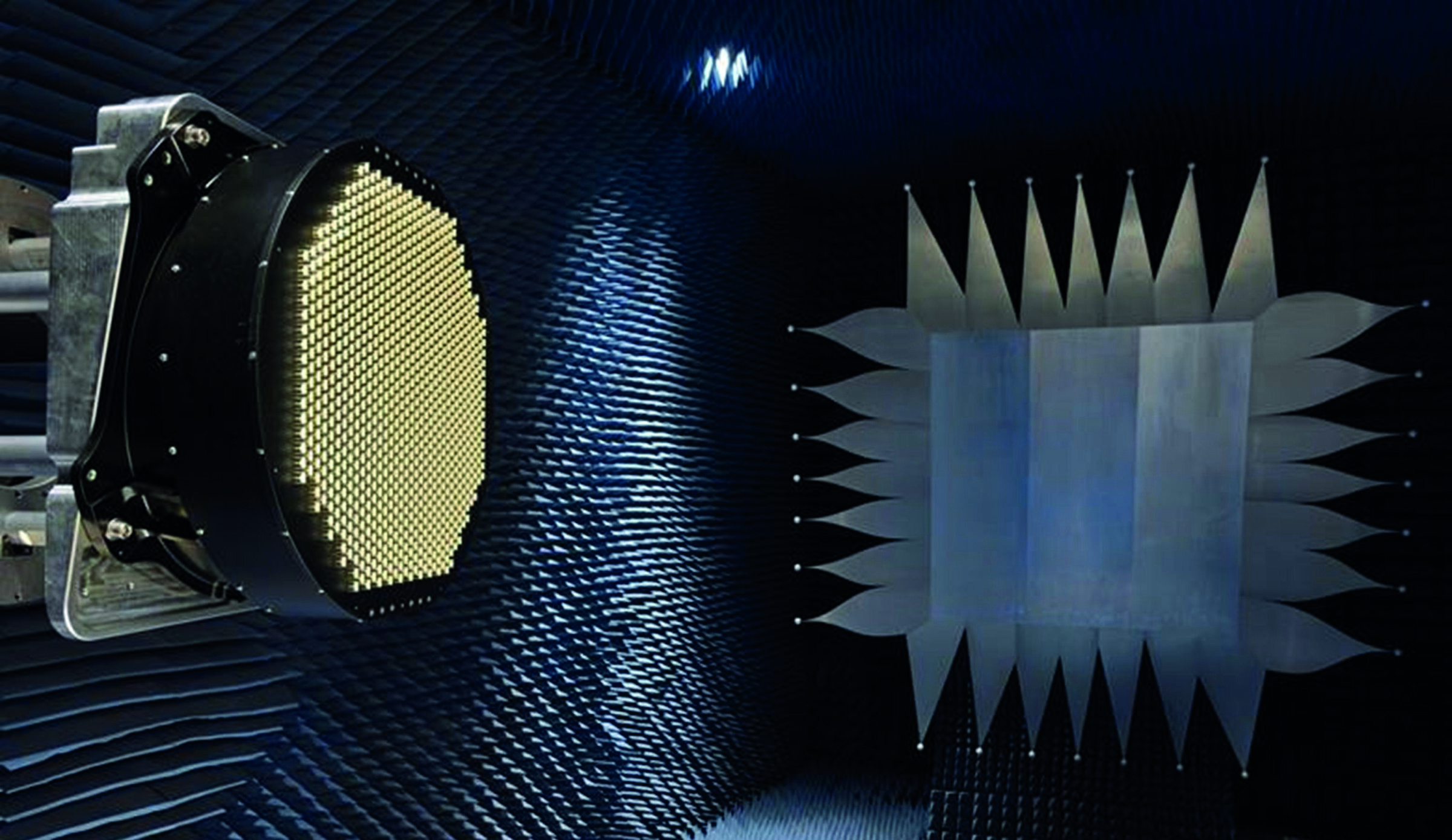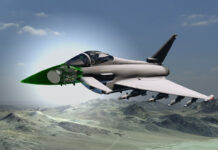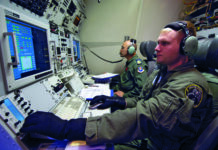Low observable airborne communications help ensure that combat aircraft can safely perform their missions while minimising their chances of detection and location via their radio emissions.
Fundamental Role
No one would doubt how vital radio is to airpower. It is the only way two or more aircraft can communicate with each other. It is the only way a pilot can communicate with those on the surface and vice versa. Radio not only carries voice traffic, but also data. This data includes everything from coordinates for targets on the surface or in the air to weather information and even radar pictures.
Yet radio has one glaring disadvantage. The moment a radio transmits that signal can theoretically be detected in the same way that one cannot speak without producing sound, no matter how quietly one whispers. Radio communications were first used en masse by airpower during the Second World War. Ever since, efforts have been ongoing to reduce the chances that signals from airborne radios can be detected. The reason why detection must be minimised is simple. Once a transmission is detected, the radio’s location can be determined and identified. If you find the source of a hostile aircraft’s radio transmission, you find the aircraft. A large part of air defence focuses on finding that hostile aircraft in the first place.
Millimetric Wave Communications
One way to reduce chances of detection via radio signals is to use Millimetric Wave (MMW) radio communications. These are at the heart of the techniques that aircraft like the Lockheed F-22A RAPTOR and F-35A/B/C LIGHTNING-II combat aircraft use to keep in touch with one another. As they are intended to flight in highly contested airspace it is imperative these planes are not located via their radio signals.
All aircraft produce a lot of radio signals. These signals are produced by radars, along with the aircraft’s radios. Radio signals are used by the plane’s Satellite Communications (SATCOM) to send and receive voice and data traffic at beyond line-of-sight ranges. High Frequency (three to 30 megahertz/MHz) radio is used for similar purposes. Aircraft carry transponders to share information with Air Traffic Control (ATC). These transponders send details of an aircraft’s identity, altitude and speed on frequencies of 1.090 gigahertz/GHz. Military aircraft transmit similar information using Identification Friend or Foe (IFF) transponders. North Atlantic Treaty Organisation aircraft frequencies of 1.030GHz and 1.090GHz to carry IFF data. An Electronic Support Measure (ESM) on the surface, or in another aircraft like an airborne early warning platform could detect these signals. Once the ESM detects these transmissions, it may be possible to determine an aircraft’s location.
MMW communications aim to reduce the likelihood of an aircraft being located via its radio signals. All radio signals mentioned above exist in wavebands of circa three megahertz up to 36GHz. MMW signals are at the upper end of this range. Typically, they exist in frequencies of 30GHz and above. They are so-called because their wavelengths are very short. Wavelength refers to the distance between a radio wave’s peaks and troughs. For example, a frequency of 30GHz has a wavelength of 9.99mm. A wavelength of 40GHz will measure 7.49mm.
Key Advantages
Millimetric wave signals have several properties making them ideal for combat aircraft needing to shield themselves from detection by ESMs. Firstly, MMW radio signals are difficult to detect as they use very narrow beams. This makes them very sharp and precise. An ESM’s receiver is unlikely to detect these beams unless its’ antenna is looking directly at them, or the beams are pointing directly to the antenna. MMW signals are comparatively much shorter range than other frequencies lower down the radio spectrum. This is not a problem for a formation of F-35s or F-22As flying relatively close together. Their radios will have sufficient power to ensure traffic reaches their comrades nearby. However, unless you are very close by these aircraft you are unlikely to be to detect their MMW radio signals using an ESM. Furthermore, if the ESM is on a hostile aircraft, it is likely this will have already been engaged by the fighter’s own ordnance before getting near the formation.
Secondly, highly directional radio antennas used by the fighters precisely steer the MMW signals to their intended recipient. This level of precision makes it unlikely that a hostile ESM will be capable of detecting the signal unless it is in the same locale as the recipient aircraft. “Directional data links have the distinct advantage of radiating minimal energy in the direction of the adversary, resulting in low probability of intercept/low probability of detection,” says a written statement from Northrop Grumman. The company is involved with the F-22A’s Intra-Flight Data Link (IFDL) and the F-35A’s Multi-Function Advanced Data Link (MADL).
The advent of MMW radio has been helped immeasurably by the advent of Active Electronically Scanned Arrays (AESAs). Initially, this technology was used in military radars from the 1990s onwards. AESAs electronically steer their signals in a certain direction. This is in contrast as to the antenna needing to be physically moved to point at its target. For MMW communications this is particularly important as it gives the high precision needed to ensure that the signal’s fine beam reaches its intended recipient. Moreover, AESAs can independently move several beams in several directions. This lets individual MMW-equipped aircraft simultaneously communicate with several other planes within range.
The Importance of AESA
AESAs have another advantage. As they can use a flat construction, akin to a solar panel, they are relatively easy to mount on an aircraft’s skin. Both the F-22A and F-35 have used this approach by mounting flat panel antennas for MMW communications on the aircraft’s surface. This means several antennas can be used to eliminate communications blind spots. These maybe caused when the aircraft performs manoeuvres, which may cause it to obstruct the line-of-sight link between two radios. It also allows the aircraft’s surfaces to remain free of protrusions, which risk compromising the jet’s low radar cross section.
Usefully, MMW communications provide high bandwidths. Data rates can be in the order of several gigabits-per-second. This allows aircraft to share data-heavy traffic like real-time video imagery with relative ease. Not only can traffic be shared, but the links provide “simultaneous voice and data”. This allows the passage of information “using secure, open systems for tactical edge processing for decision dominance at mission speed.”
Datalinks like IFDL and MADL not only exist to ensure similar aircraft can remain in contact. They play a role enriching the situational awareness of a group of aircraft. One of airpower’s greatest strengths is mass which can be focused at an optimum moment against hostile targets. By using these links, a package of F-22As or F-35s becomes noticeably stronger than the sum of its parts. “These data links allow true machine-to-machine data exchanges that enable the onboard computers to create a fused picture”, says Northrop Grumman’s statement. This is “a capability unsurpassed by traditional links such as Link-16”. In fact, MMW data communications rates are a far cry from the 115.2 kilobits-per-second which the North Atlantic Treaty Organisation’s (NATO’s) Link-16 Tactical Datalink (TDL) theoretically achieves. Experts tell the author that Link-16 is usually only capable of handling noticeably lower levels of traffic.
While MMW communications have advantages regarding the traffic levels they handle and their relatively furtive attributes, they do have disadvantages. Perhaps the most serious is atmospheric attenuation. This is when atmospheric moisture absorbs radio waves at certain frequencies as they pass through the atmosphere. As MMW frequencies use very short wavelengths of 10mm or less, signals can be impeded by rain6drops and snowflakes. These obscurants will not necessarily prevent the signals reaching their recipient, but they will degrade their efficacy.
Tactics
At first blush, it might seem that the relatively short range and high precision of the MMW transmissions used by aircraft like the F-22A or F-35 prevent them from commun6icating with other aircraft outside their locale. To an extent, this is the case. However, tactics can be used to ensure the aircraft can send and receive traffic to and from other aircraft. Typically, these aircraft will work in pairs within larger formations. Perhaps three or four jets will ingress into contested airspace. These aircraft will communicate between themselves using the MMW radio.
Another F-22A or F-35 may hang back slightly from the formation perhaps remaining in friendly, or relatively safe, airspace. It will receive any traffic from the aircraft in the hostile airspace intended for recipients outside the formation. That aircraft’s radios will translate the traffic from the formation into another protocol like Link-16. This will then be transmitted to its intended recipients on the Link-16 network. This process can be reversed for traffic from outside intended for the formation. On the one hand, the formation preserves its stealth, while on the other it remains in touch with other assets involved in the operation.
Developments
The two notable, low-observable communications systems in service today on are the IFDL and MADL. It is thought that MADL was essentially a further development of the earlier IFDL architecture. Details of the communications used by the Russian Air Force’s Sukhoi Su-57 (NATO reporting name Felon) are harder to find. Reports from Russia’s TASS news agency say that the Su-57 uses a communications system known as S-111. Precisely what this consists of remains unknown.
The TASS report revealing the system in July 2019 said the S-111 “provides radio … communications and an exchange of the plane’s data with other aircraft (and with) with ground, aerial and naval command and control posts”. It continued that “the equipment incorporates the state-of-the-art technology (for) high-speed data transmission and features advanced network solutions.” It seems likely Russian radio engineers are looking at MMW communications for combat aircraft. Such technology may indeed already be in service onboard the Su-57 in the guise of the S-111. Likewise, MMW communications may be used by the People’s Liberation Army Air Force Chengdu J-20A fifth-generation fighter.
MMW technology not only relies on being difficult to detect to preserve its low-observable characteristics. While highly classified, one can assume that other techniques like encryption and frequency-hopping are used. This will help make MMW traffic hard to detect and intercept. Western airpower is now moving beyond the first generation of airborne tactical MMW architectures as enshrined in the IFDL and MADL. Europe is moving ahead on two sixth-generation combat aircraft, the multinational Tempest and Future Combat Air System. The US Air Force is developing its Next-Generation Air Dominance (NGAD) platform. Meanwhile, the US Navy is working on the F/A-XX programme. All these aircraft will enter service in the 2030s and will all include the next-generation of low-observable communications.
Real World Applications
What will these architectures look like in practice? At this point it is difficult to say. For understandable reasons, many aspects of these aircraft’s capabilities remain in classified. It is safe to assume that millimetric wave communications will continue to be favoured for the reasons given above. Whether signals move further up the radio spectrum beyond 40GHz remains to be seen. Higher frequencies will bring even more precise beams and wider bandwidths, but they will do so at the expense of range and power. MMW communications using higher frequencies maybe impractical. As frequencies increase, more power is needed to send the transmissions across equivalent distances. There is a limit to how much electricity an aircraft’s engines can generate, and this power must be shared with other aircraft systems. A compromise will have to be struck between desired MMW frequencies and those practical for the aircraft.
Instead, further innovations could be rolled into MMW architecture in other ways. Transmission and communications security protocols may be improved with more robust encryption. Similarly, cognitive techniques maybe embedded into MMW processes. Cognitive radio is an emerging technology. It enables a radio to continually sense the electromagnetic environment modifying its behaviour with no human intervention. This is achieved by using artificial intelligence and machine learning.
The radio is capable of continually ‘learning’ from its experiences and altering its comportment to ensure it remains efficient. For example, the radio may have learned it needs to use less power transmitting traffic on days when the weather is good. Correspondingly, the radio automatically moderates its transmission power when weather data tells the radio it is a fine day. Alternatively, a radio may learn which of its transmissions successfully reached their recipient during previous missions when heavy electronic jamming was experienced. Once again, the radio automatically adjusts its behaviour accordingly when experiencing similar jamming in the future.
Low-observable airborne radio technology is still a relatively young science. The IFDL and MADL can trace their lineage back to the 1980s when the US airpower community began thinking about the F-22A and F-35. MMW communications help preserve stealth while enabling secure, high bandwidth communications. The next iterations of this technology destined for forthcoming sixth-generation fighters will take things even further.










